Monitoring of Thermal Aging of Aluminum Alloy via Nonlinear Propagation of Acoustic Pulses Generated and Detected by Lasers
Abstract
:Featured Application
Abstract
1. Introduction
2. Materials and Methods
2.1. Mechanism of Finite-Amplitude Acoustic Wave Generation
2.2. The Experimental Setup and Procedures
3. Results
3.1. The Generation of Finite-Amplitude Acoustic Wave with Liquid-Suspended Carbon Particles (LSCP) Layer
3.2. Distortion of Direct Longitudinal Waves
3.3. Quantitative Evaluation of the Hysteretic Quadratic Nonlinearity of Aluminum Alloy
4. Discussion
5. Conclusions
Author Contributions
Funding
Acknowledgments
Conflicts of Interest
References
- Cantrell, J.H. Substructural organization, dislocation plasticity and harmonic generation in cyclically stressed wavy slip metals. Proc. R. Soc. Math. Phys. Eng. Sci. 2004, 460, 757–780. [Google Scholar] [CrossRef]
- Xiang, Y.X.; Zhu, W.J.; Liu, C.J.; Xuan, F.Z.; Wang, Y.N.; Kuang, W.C. Creep degradation characterization of titanium alloy using nonlinear ultrasonic technique. NDT E Int. 2015, 72, 41–49. [Google Scholar] [CrossRef]
- Rauter, N.; Lammering, R.; Kuhnrich, T. On the detection of fatigue damage in composites by use of second harmonic guided waves. Compos. Struct. 2016, 152, 247–258. [Google Scholar] [CrossRef]
- Hess, P. Surface acoustic waves in materials science. Phys. Today 2002, 55, 42–47. [Google Scholar] [CrossRef]
- Hitchman, S.; van Wijk, K.; Davidson, Z. Monitoring attenuation and the elastic properties of an apple with laser ultrasound. Postharvest Biol. Technol. 2016, 121, 71–77. [Google Scholar] [CrossRef]
- Cavuto, A.; Martarelli, M.; Pandarese, G.; Revel, G.M.; Tomasini, E.P. Train wheel diagnostics by laser ultrasonics. Measurement 2016, 80, 99–107. [Google Scholar] [CrossRef]
- Hayashi, T. Non-contact imaging of pipe thinning using elastic guided waves generated and detected by lasers. Int. J. Press. Vessel. Pip. 2017, 153, 26–31. [Google Scholar] [CrossRef]
- Karabutov, A.A.; Podymova, N.B.; Cherepetskaya, E.B. Determination of uniaxial stresses in steel 816 structures by the laser–ultrasonic method. J. Appl. Mech. Tech. Phys. 2017, 58, 503–510. [Google Scholar] [CrossRef]
- Cherepetskaya, E.B.; Karabutov, A.A.; Mironova, E.A.; Podymova, N.B.; Zharinov, A.N. Contact laser-ultrasonic evaluation of residual stress. Appl. Mech. Mater. 2016, 843, 118–124. [Google Scholar] [CrossRef]
- Podymova, N.B.; Karabutov, A.A. Combined effects of reinforcement fraction and porosity on ultrasonic velocity in SiC particulate aluminum alloy matrix composites. Compos. Part B Eng. 2017, 113, 138–143. [Google Scholar] [CrossRef]
- Bychkov, A.; Simonova, V.; Zarubin, V.; Cherepetskaya, E.; Karabutov, A. The Progress in Photoacoustic and Laser Ultrasonic Tomographic Imaging for Biomedicine and Industry: A Review. Appl. Sci. 2018, 8, 1931. [Google Scholar] [CrossRef]
- Glushkov, E.; Glushkova, N.; Bonello, B.; Lu, L.; Charron, E.; Gogneau, N.; Julien, F.; Tchernycheva, M.; Boyko, O. Evaluation of Effective Elastic Properties of Nitride NWs/Polymer Composite Materials Using Laser-Generated Surface Acoustic Waves. Appl. Sci. 2018, 8, 2319. [Google Scholar] [CrossRef]
- Patel, R.; Hirsch, M.; Dryburgh, P.; Pieris, D.; Achamfuo-Yeboah, S.; Smith, R.; Light, R.; Sharples, S.; Clare, A.; Clark, M. Imaging Material Texture of As-Deposited Selective Laser Melted Parts Using Spatially Resolved Acoustic Spectroscopy. Appl. Sci. 2018, 8, 1991. [Google Scholar] [CrossRef]
- Nagy, P.B. Fatigue damage assessment by nonlinear ultrasonic materials characterization. Ultrasonics 1998, 36, 375–381. [Google Scholar] [CrossRef]
- Deng, M.X. Characterization of surface properties of a solid plate using nonlinear Lamb wave approach. Ultrasonics 2006, 44, E1157–E1162. [Google Scholar] [CrossRef]
- Kim, C.S.; Kwun, S.I.; Park, I.K. Characterization of creep-fatigue in ferritic 9Cr-Mo-V-Nb steel using ultrasonic velocity. J. Nucl. Mater. 2008, 377, 496–500. [Google Scholar] [CrossRef]
- Li, W.; Cho, Y.; Lee, J.; Achenbach, J.D. Assessment of Heat Treated Inconel X-750 Alloy by Nonlinear Ultrasonics. Exp. Mech. 2013, 53, 775–781. [Google Scholar] [CrossRef]
- Na, J.K.; Breazeale, M.A. Ultrasonic nonlinear properties of lead zirconate-titanate ceramics. J. Acoust. Soc. Am. 1994, 95, 3213–3221. [Google Scholar] [CrossRef]
- Bonner, B.P.; Wanamaker, B.J. Nonlinear acoustic effects in rocks and soils. In Review of Progress in Quantitative Nondestructive Evaluation; Thompson, D.O., Chimenti, D.E., Eds.; Springer: Boston, MA, USA, 1990; Volume 9, pp. 1709–1713. ISBN 978-1-4684-5772-8. [Google Scholar]
- Shkolnik, I.; Zarembo, L.; Krasilnikov, V. On structural non-linear diagnostics of solids and estimation of their strength. In Frontiers of Nonlinear Acoustics, Proceedings of the 12th ISNA, Austin, TX, USA, 27–31 August 1990; Hamilton, M.F., Blackstock, D.T., Eds.; Elsevier Science: London, UK, 1990. [Google Scholar]
- Nazarov, V.E. Sound damping by sound in metals. Acoust. Lett. 1991, 15, 22–25. [Google Scholar]
- Zinszner, B.; Johnson, P.A.; Rasolofosaon, P.N.J. Influence of change in physical state on elastic nonlinear response in rock: Significance of effective pressure and water saturation. J. Geophys. Res. 1997, 102, 8105–8120. [Google Scholar] [CrossRef] [Green Version]
- Xiang, Y.X.; Deng, M.X.; Xuan, F.Z.; Liu, C.J. Cumulative second-harmonic analysis of ultrasonic Lamb waves for ageing behavior study of modified-HP austenite steel. Ultrasonics 2011, 51, 974–981. [Google Scholar] [CrossRef]
- Amura, M.; Meo, M. Prediction of residual fatigue life using nonlinear ultrasound. Smart Mater. Struct. 2012, 21, 045001. [Google Scholar] [CrossRef]
- Blackshire, J.L.; Sathish, S.; Na, J.; Frouin, J. Nonlinear laser ultrasonic measurements of localized fatigue damage. In Proceedings of the 29th Annual Review of Progress in Quantitative Nondestructive Evaluation, Bellingham, WA, USA, 14–19 July 2002. [Google Scholar]
- Li, W.; Cho, Y. Thermal Fatigue Damage Assessment in an Isotropic Pipe Using Nonlinear Ultrasonic Guided Waves. Exp. Mech. 2014, 54, 1309–1318. [Google Scholar] [CrossRef]
- Li, W.; Cho, Y.; Achenbach, J.D. Detection of thermal fatigue in composites by second harmonic Lamb waves. Smart Mater. Struct. 2012, 21, 085019. [Google Scholar] [CrossRef]
- Valluri, J.S.; Balasubramaniam, K.; Prakash, R.V. Creep damage characterization using non-linear ultrasonic techniques. Acta Mater. 2010, 58, 2079–2090. [Google Scholar] [CrossRef]
- Cantrell, J.H.; Zhang, X.G. Nonlinear acoustic response from precipitate-matrix misfit in a dislocation network. J. Appl. Phys. 1998, 84, 5469–5472. [Google Scholar] [CrossRef]
- Herrmann, J.; Kim, J.Y.; Jacobs, L.J.; Qu, J.M.; Littles, J.W.; Savage, M.F. Assessment of material damage in a nickel-base superalloy using nonlinear Rayleigh surface waves. J. Appl. Phys. 2006, 99, 124913. [Google Scholar] [CrossRef]
- Rao, V.; Kannan, E.; Prakash, R.V.; Balasubramaniam, K. Fatigue damage characterization using surface acoustic wave nonlinearity in aluminum alloy AA7175-T7351. J. Appl. Phys. 2008, 104, 123508. [Google Scholar] [CrossRef]
- Walker, S.V.; Kim, J.Y.; Qu, J.M.; Jacobs, L.J. Fatigue damage evaluation in A36 steel using nonlinear Rayleigh surface waves. NDT E Int. 2012, 48, 10–15. [Google Scholar] [CrossRef]
- Barnard, D.J.; Dace, G.E.; Buck, O. Acoustic harmonic generation due to thermal embrittlement of Inconel 718. J. Nondestruct. Eval. 1997, 16, 67–75. [Google Scholar] [CrossRef]
- Nam, T.; Choi, S.; Lee, T.; Jhang, K.Y.; Kim, C.S. Acoustic Non linearity of Narrowband Laser-generated Surface Waves in the Bending Fatigue of Al6061 Alloy. J. Korean Phys. Soc. 2010, 57, 1212–1217. [Google Scholar] [CrossRef]
- Pruell, C.; Kim, J.Y.; Qu, J.; Jacobs, L.J. A nonlinear-guided wave technique for evaluating plasticity-driven material damage in a metal plate. NDT E Int. 2009, 42, 199–203. [Google Scholar] [CrossRef]
- Zeitvogel, D.T.; Matlack, K.H.; Kim, J.Y.; Jacobs, L.J.; Singh, P.M.; Qu, J. Characterization of stress corrosion cracking in carbon steel using nonlinear Rayleigh surface waves. NDT E Int. 2014, 62, 144–152. [Google Scholar] [CrossRef]
- Thiele, S.; Kim, J.Y.; Qu, J.; Jacobs, L.J. Air-coupled detection of nonlinear Rayleigh surface waves to assess material nonlinearity. Ultrasonics 2014, 54, 1470–1475. [Google Scholar] [CrossRef]
- Thiele, S.; Matlack, K.H.; Kim, J.Y.; Qu, J.; Wall, J.J.; Jacobs, L.J. Assessment of precipitation in alloy steel using nonlinear Rayleigh surface waves. In Proceedings of the 10th International Conference on Barkhausen and Micro-Magnetics (ICBM), Baltimore, MD, USA, 21–26 July 2013. [Google Scholar]
- Sohn, H.; Lim, H.J.; Desimio, M.P.; Brown, K.; Derriso, M. Nonlinear ultrasonic wave modulation for online fatigue crack detection. J. Sound Vib. 2014, 333, 1473–1484. [Google Scholar] [CrossRef]
- Xiang, Y.X.; Deng, M.X.; Xuan, F.Z.; Liu, C.J. Effect of precipitate-dislocation interactions on generation of nonlinear Lamb waves in creep-damaged metallic alloys. J. Appl. Phys. 2012, 111, 375. [Google Scholar] [CrossRef]
- Hong, M.; Su, Z.; Lu, Y.; Sohn, H.; Qing, X. Locating fatigue damage using temporal signal features of nonlinear Lamb waves. Mech. Syst. Signal Process. 2015, 60–61, 182–197. [Google Scholar] [CrossRef]
- Gao, G.; Li, D.; Shi, D.; Dong, J. Detection on Fatigue Crack of Aluminum Alloy Plate Based on Modulation Nonlinear Lamb Waves and Time Reversal Method. Procedia Eng. 2012, 29, 1373–1377. [Google Scholar] [CrossRef] [Green Version]
- Xiang, W.; Zhang, Q.; Xu, G.; Tse, P.W. Numerical Simulation of Nonlinear Lamb Waves Used in a Thin Plate for Detecting Buried Micro-Crack. Sensors 2014, 14, 8528–8546. [Google Scholar] [CrossRef]
- Baby, S.; Kowmudi, B.N.; Omprakash, C.M.; Satyanarayana, D.V.V.; Balasubramaniam, K.; Kumar, V. Creep damage assessment in titanium alloy using a nonlinear ultrasonic technique. Scr. Mater. 2008, 59, 818–821. [Google Scholar] [CrossRef]
- Zhu, W.; Deng, M.; Xiang, Y.; Xuan, F.Z.; Liu, C.; Wang, Y.N. Modeling of ultrasonic nonlinearities for dislocation evolution in plastically deformed materials: Simulation and experimental validation. Ultrasonics 2016, 68, 134–141. [Google Scholar] [CrossRef]
- Cantrell, J.H.; Yost, W.T. Nonlinear ultrasonic characterization of fatigue microstructures. Int. J. Fatigue 2001, 23, 487–490. [Google Scholar] [CrossRef]
- Shui, G.; Wang, Y.S.; Huang, P.; Qu, J. Nonlinear ultrasonic evaluation of the fatigue damage of adhesive joints. NDT E Int. 2015, 70, 9–15. [Google Scholar] [CrossRef]
- Hong, J.Y.; Kim, J.H.; Park, S.J.; Kwak, H.G. Characterization of thermally damaged concrete using a nonlinear ultrasonic method. Cem. Concr. Res. 2012, 42, 1438–1446. [Google Scholar] [CrossRef]
- Sohn, Y.; Krishnaswamy, S. Interaction of a scanning laser-generated ultrasonic line source with a surface-breaking flaw. J. Acoust. Soc. Am. 2004, 115, 172–181. [Google Scholar] [CrossRef]
- Shan, Q.; Dewhurst, R.J. Surface-breaking fatigue crack detection using laser ultrasound. Appl. Phys. Lett. 1993, 62, 2649–2651. [Google Scholar] [CrossRef]
- Grégoire, G.; Tournat, V.; Mounier, D.; Gusev, V.E. Nonlinear photothermal and photoacoustic processes for crack detection. Eur. Phys. J. Spec. Top. 2008, 153, 313–315. [Google Scholar] [CrossRef]
- Mezil, S.; Chigarev, N.; Tournat, V.; Gusev, V.E. All-optical probing of the nonlinear acoustics of a crack. Opt. Lett. 2011, 36, 3449–3451. [Google Scholar] [CrossRef]
- Lomonosov, A.; Hess, P. Effects of Nonlinear Elastic Surface Pulses in Anisotropic Silicon Crystals. Phys. Rev. Lett. 1999, 83, 3876–3879. [Google Scholar] [CrossRef]
- Lomonosov, A.; Mikhalevich, V.G.; Hess, P.; Knight, E.Y.; Hamilton, M.F.; Zabolotskaya, E.A. Laser-generated nonlinear Rayleigh waves with shocks. J. Acoust. Soc. Am. 1999, 105, 2093–2096. [Google Scholar] [CrossRef]
- Lomonosov, A.; Hess, P.; Mayer, A.P. Observation of solitary elastic surface pulses. Phys. Rev. Lett. 2002, 88, 076104. [Google Scholar] [CrossRef]
- Seo, H.; Jun, J.; Jhang, K.Y. Assessment of Thermal Aging of Aluminum Alloy by Acoustic Nonlinearity Measurement of Surface Acoustic Waves. Res. Nondestr. Eval. 2017, 28, 3–17. [Google Scholar] [CrossRef]
- Gusev, V. Propagation of the acoustic pulses in the materials with hysteretic nonlinearity. J. Acoust. Soc. Am. 2000, 107, 3047–3058. [Google Scholar] [CrossRef]
- Cabaret, J.; Béquin, P.; Theocharis, G.; Andreev, V.; Gusev, V.E.; Tournat, V. Nonlinear Hysteretic Torsional Waves. Phys. Rev. Lett. 2015, 115, 054301. [Google Scholar] [CrossRef]
- Radostin, A. Acoustic pulses in media with power law hysteretic nonlinearity. Acta Acust. United Acust. 2018, 104, 410–416. [Google Scholar] [CrossRef]
- Yasumoto, Y.; Nakamura, A.; Takeuchi, R. Developments in the use of acoustic shock pulses in the study of elastic properties of solids. Acustica 1974, 30, 260–267. [Google Scholar] [CrossRef]
- Nazarov, V.E. Nonlinear acoustic effects in annealed copper. Sov. Phys. Acoust. 1991, 37, 75–78. [Google Scholar]
- In’kov, V.N.; Cherepetskaya, E.B.; Shkuratnik, V.L.; Karabutov, A.A.; Makarov, V.A. Ultrasonic laser spectroscopy of mechanic-acoustic nonlinearity of cracked rocks. J. Appl. Mech. Tech. Phys. 2005, 46, 452–457. [Google Scholar] [CrossRef]
- Nazarov, V.E.; Ostrovsky, L.A.; Soustova, I.A.; Sutin, A.M. Nonlinear acoustics of micro-inhomogeneous media. Phys. Earth Planet. Int. 1998, 50, 65–73. [Google Scholar] [CrossRef]
- Guyer, R.A.; Johnson, P.A. Nonlinear Mesoscopic Elasticity: Evidence for a new class of materials. Phys. Today 1999, 52, 30–36. [Google Scholar] [CrossRef]
- Gusev, V.E.; Tournat, V.; Castagnède, B. Nonlinear acoustic phenomena in micro-inhomogeneous materials. In Materials and Acoustics Handbook; Bruneau, M., Potel, C., Eds.; John Wiley & Sons, Inc.: Hoboken, NJ, USA, 2009; pp. 433–472. ISBN 9781848210745. [Google Scholar]
- Zarembo, L.V.; Krasilnikov, V.A. Nonlinear phenomena in the propagation of elastic waves in solids. Sov. Phys. Usp. 1971, 13, 778–797. [Google Scholar] [CrossRef]
- Rudenko, O.V.; Soluyan, S.I. Theoretical Foundations of Nonlinear Acoustics; Consultant Bureau: New York, NY, USA, 1977; ISBN 978-1-4899-4796-3. [Google Scholar]
- Gusev, V.E.; Karabutov, A.A. Quasisynchronous sound excitation under acoustic nonlinearity conditions. In Laser Optoacoustics; American Institute of Physics: New York, NY, USA, 1993; pp. 173–234. ISBN 1-56396-036-2. [Google Scholar]
- Nazarov, V.E.; Ostrovskii, L.A.; Soustova, I.A.; Sutin, A.M. Anomalous acoustic nonlinearity in metals. Sov. Phys. Acoust. 1988, 34, 284–289. [Google Scholar]
- Cantrell, J.H.; Yost, W.T. Effect of precipitate coherency strains on acoustic harmonic generation. J. Appl. Phys. 1997, 81, 2957–2962. [Google Scholar] [CrossRef]
- Dutta, I.; Allen, S.M.; Hafley, J.L. Effect of reinforcement on the aging response of cast 6061 Al-Al203 particulate composites. Metall. Trans. A 1991, 22, 2553–2563. [Google Scholar] [CrossRef]
- Edwards, G.A.; Stiller, K.; Dunlop, G.L.; Couper, M.J. The precipitation sequence in Al-Mg-Si alloys. Acta Mater. 1998, 46, 3893–3904. [Google Scholar] [CrossRef]
- Murayama, M.; Hono, K.; Saga, M.; Kikuchi, M. Atom probe studies on the early stages of precipitation in Al-Mg-Si alloys. Mater. Sci. Eng. A Struct. Mater. Prop. Microstruct. Process. 1998, 250, 127–132. [Google Scholar] [CrossRef]
- Murayama, M.; Hono, K. Pre-precipitate clusters and precipitation processes in Al-Mg-Si alloys. Acta Mater. 1999, 47, 1537–1548. [Google Scholar] [CrossRef]
- Fang, X.; Song, M.; Li, K.; Du, Y. Precipitation sequence of an aged Al-Mg-Si alloy. J. Min. Metall. Sect. B Metall. 2010, 46, 171–180. [Google Scholar] [CrossRef]

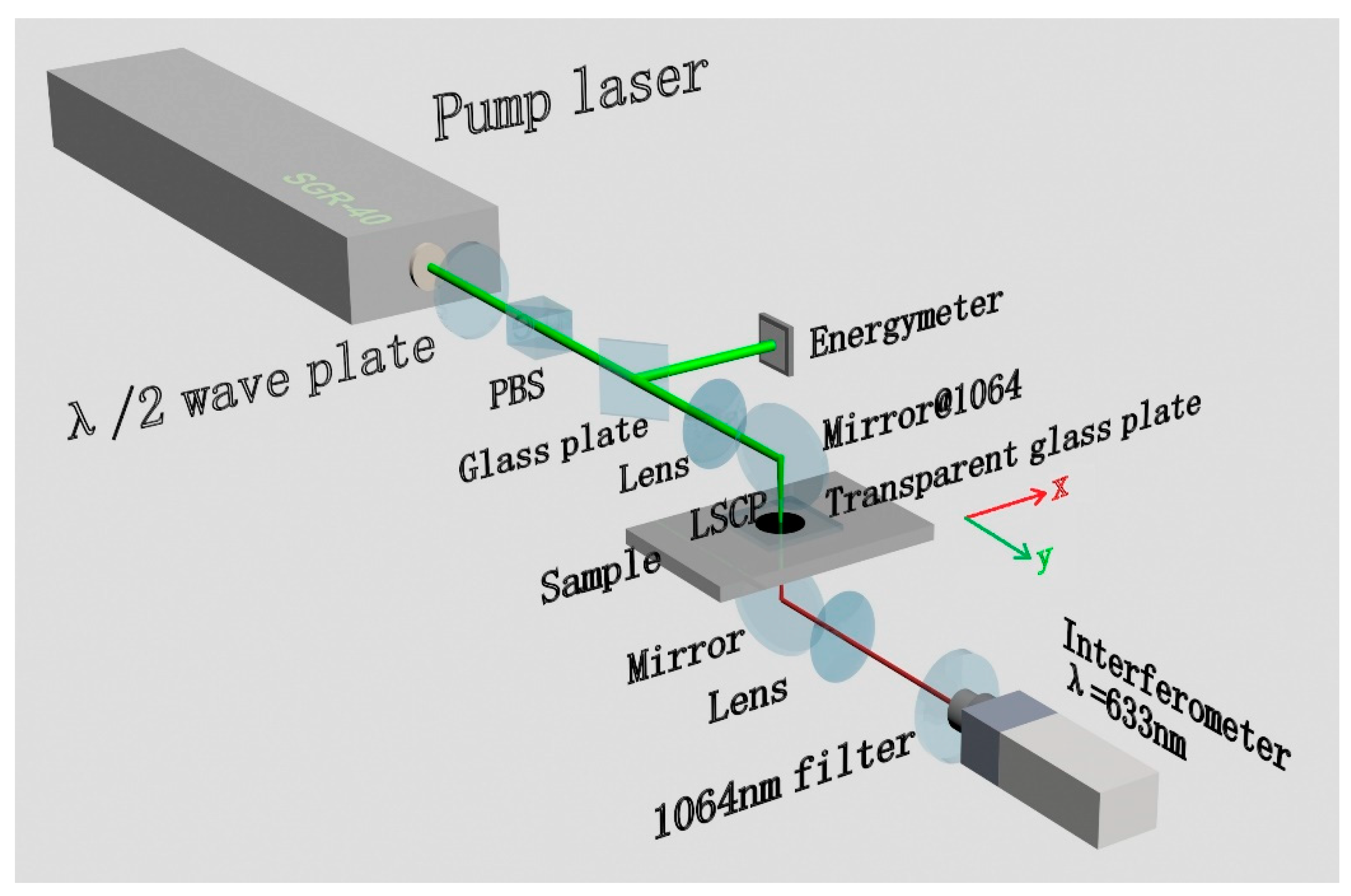
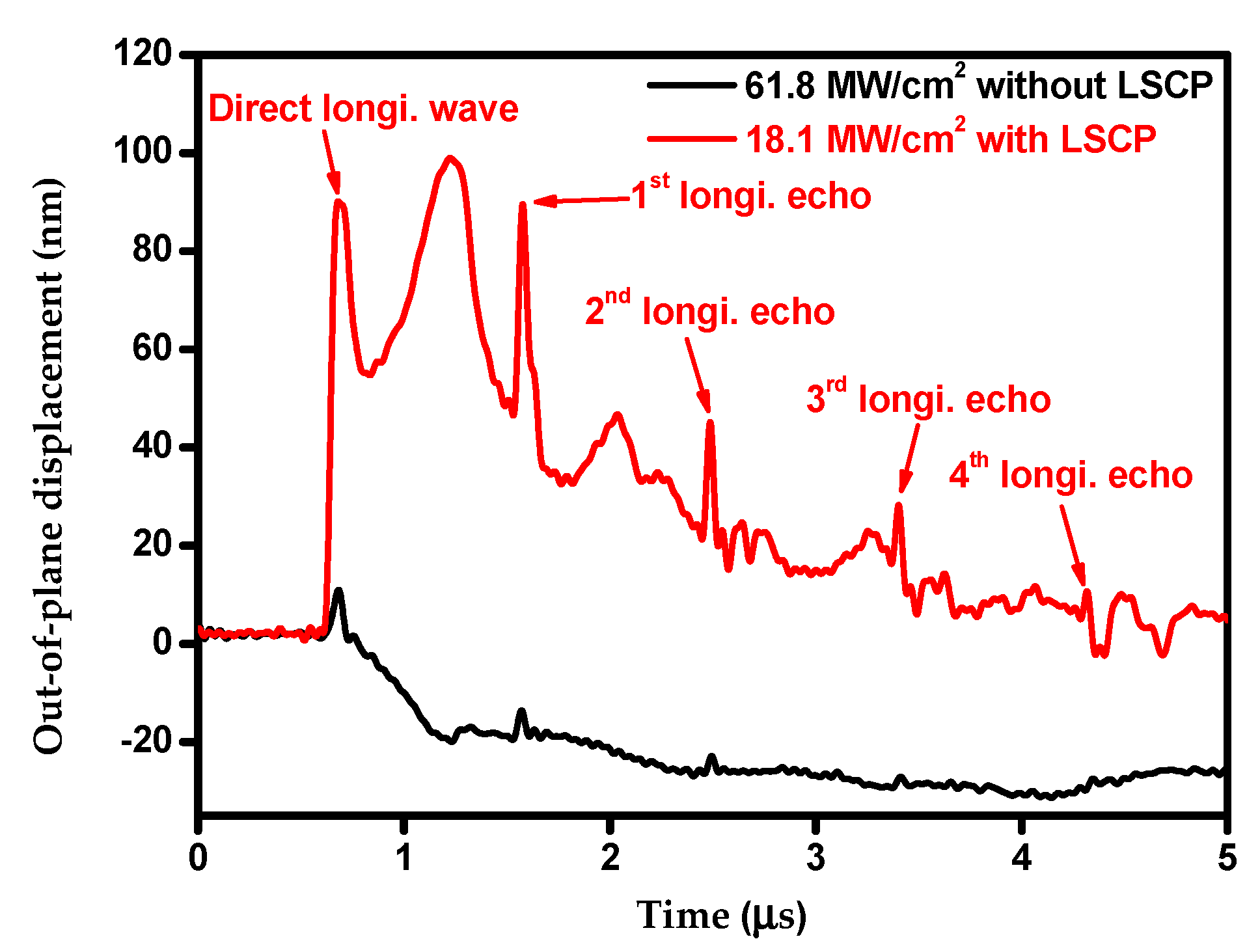
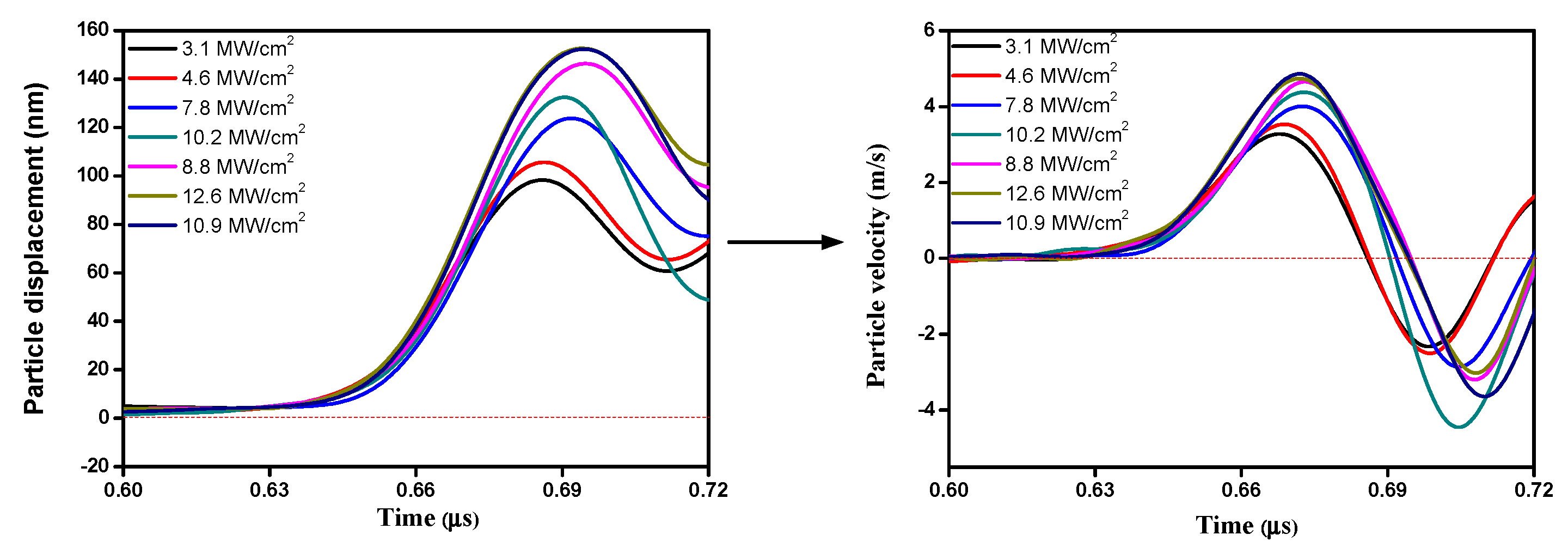
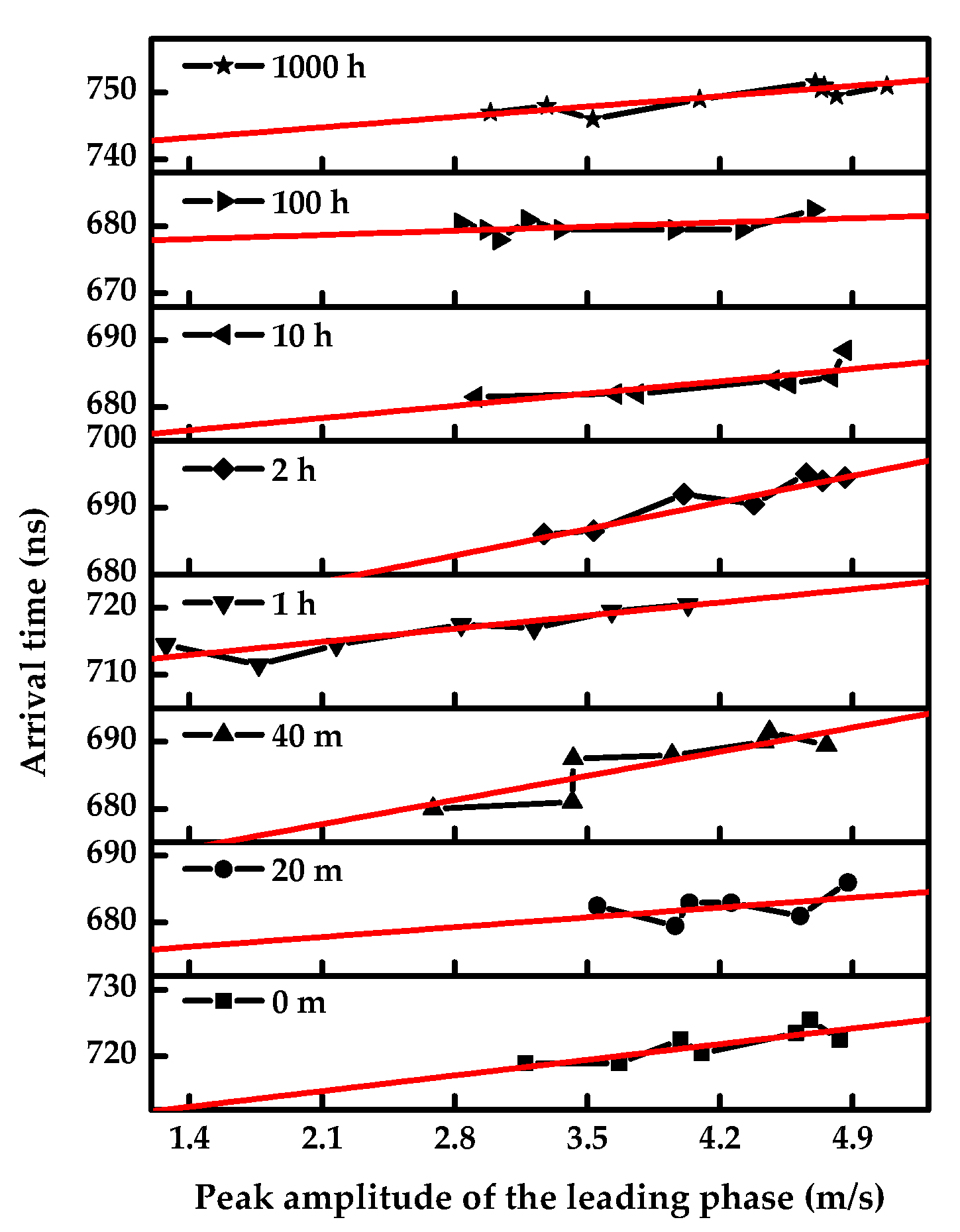
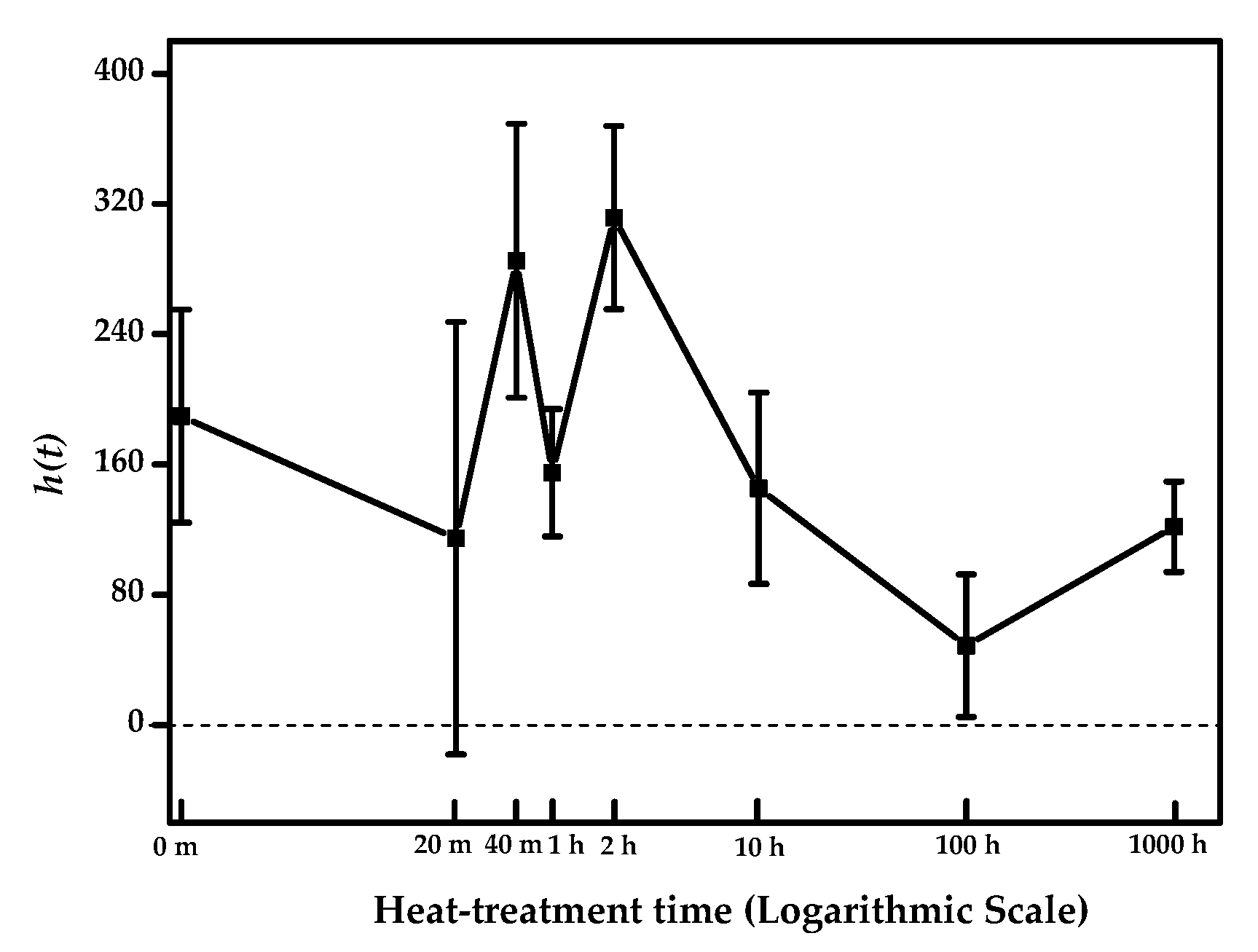
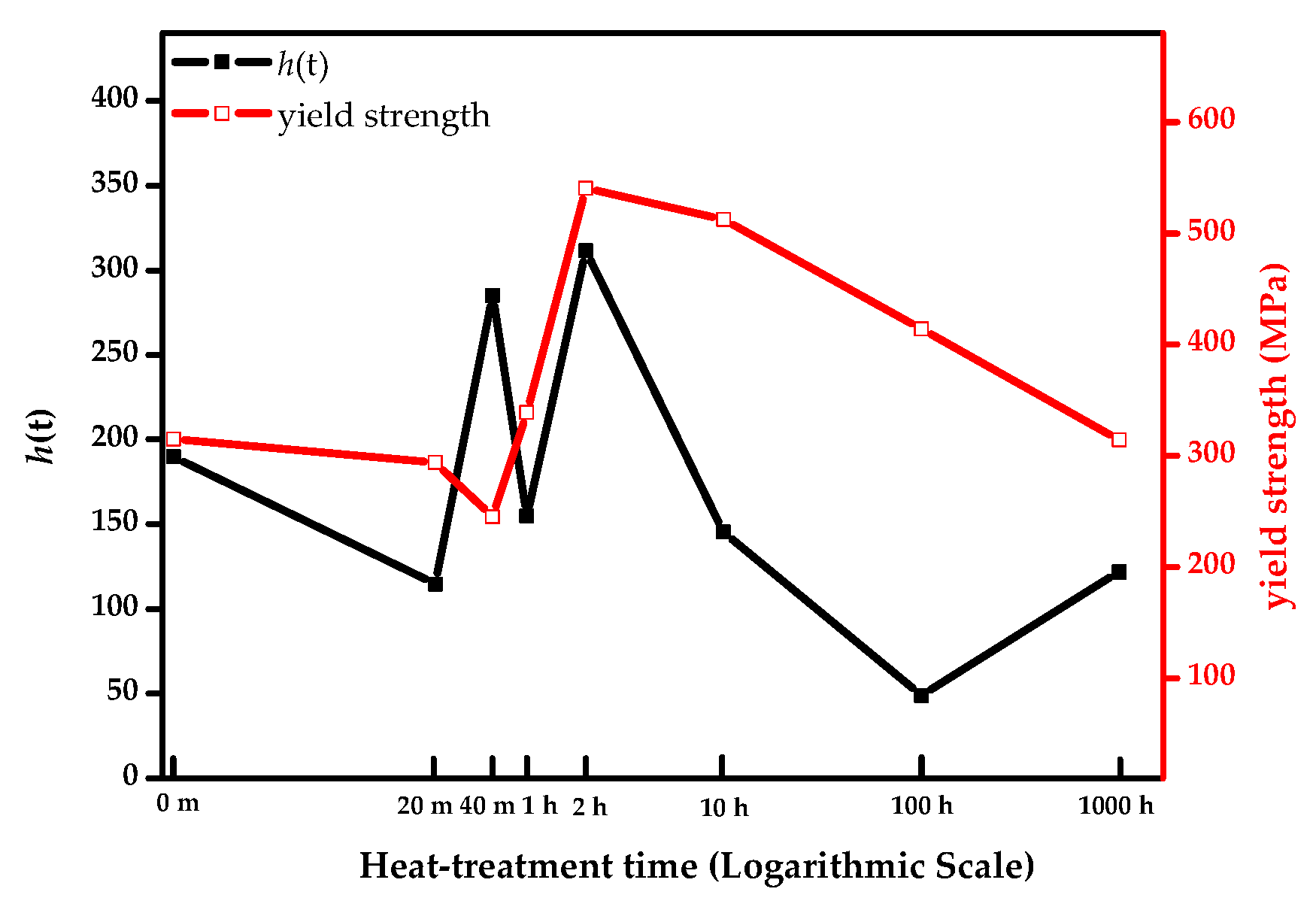
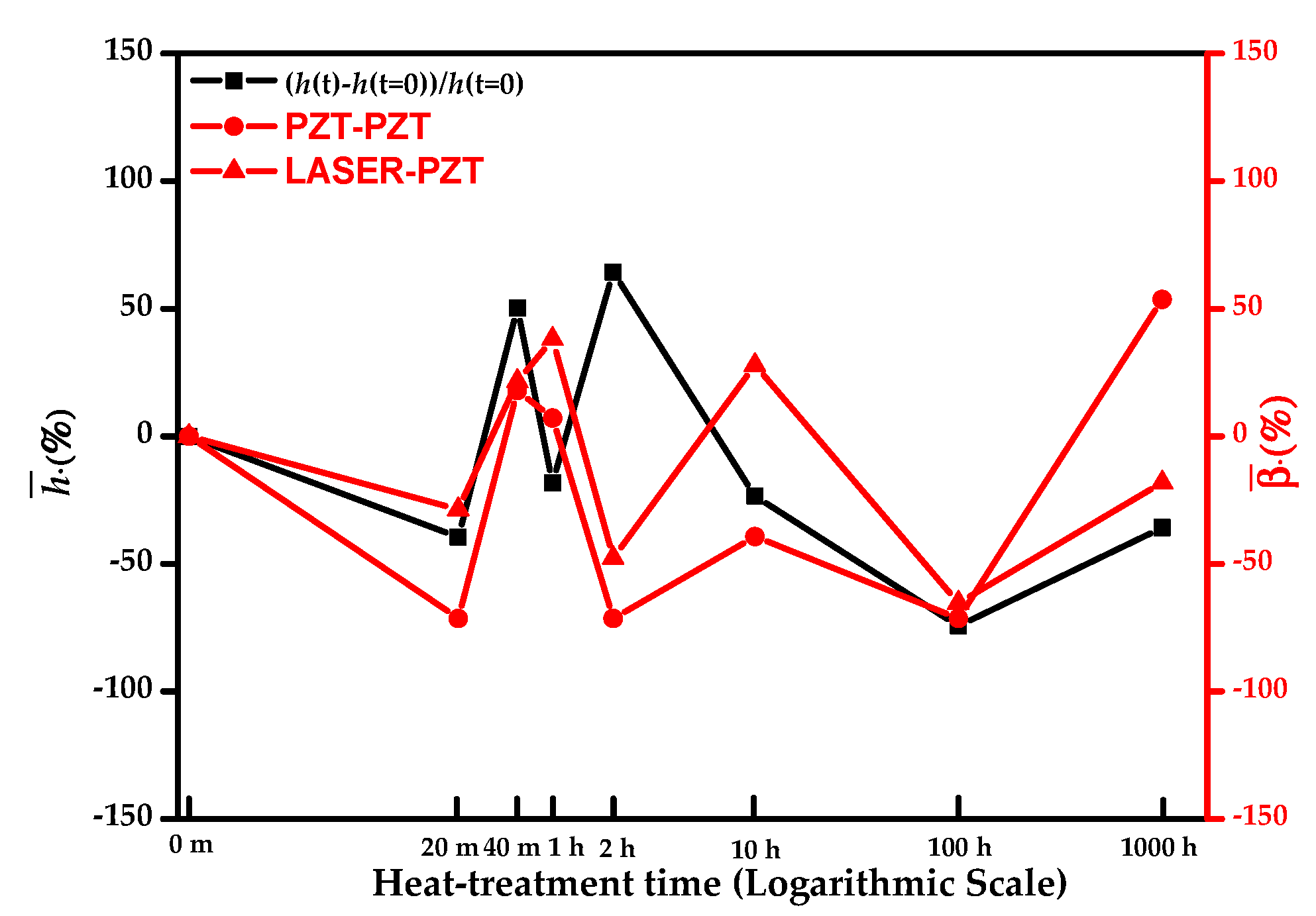
© 2019 by the authors. Licensee MDPI, Basel, Switzerland. This article is an open access article distributed under the terms and conditions of the Creative Commons Attribution (CC BY) license (http://creativecommons.org/licenses/by/4.0/).
Share and Cite
Li, M.; Lomonosov, A.M.; Shen, Z.; Seo, H.; Jhang, K.-Y.; Gusev, V.E.; Ni, C. Monitoring of Thermal Aging of Aluminum Alloy via Nonlinear Propagation of Acoustic Pulses Generated and Detected by Lasers. Appl. Sci. 2019, 9, 1191. https://doi.org/10.3390/app9061191
Li M, Lomonosov AM, Shen Z, Seo H, Jhang K-Y, Gusev VE, Ni C. Monitoring of Thermal Aging of Aluminum Alloy via Nonlinear Propagation of Acoustic Pulses Generated and Detected by Lasers. Applied Sciences. 2019; 9(6):1191. https://doi.org/10.3390/app9061191
Chicago/Turabian StyleLi, Mengmeng, Alexey M. Lomonosov, Zhonghua Shen, Hogeon Seo, Kyung-Young Jhang, Vitalyi E. Gusev, and Chenyin Ni. 2019. "Monitoring of Thermal Aging of Aluminum Alloy via Nonlinear Propagation of Acoustic Pulses Generated and Detected by Lasers" Applied Sciences 9, no. 6: 1191. https://doi.org/10.3390/app9061191
APA StyleLi, M., Lomonosov, A. M., Shen, Z., Seo, H., Jhang, K.-Y., Gusev, V. E., & Ni, C. (2019). Monitoring of Thermal Aging of Aluminum Alloy via Nonlinear Propagation of Acoustic Pulses Generated and Detected by Lasers. Applied Sciences, 9(6), 1191. https://doi.org/10.3390/app9061191







